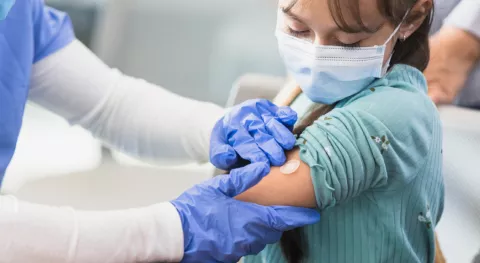
Every day, we are learning new things about coronavirus (COVID-19) and the way it spreads.
The virus mainly spreads through people who are in close contact with each other. When someone who is infected (with or without symptoms) coughs, sneezes or speaks, they produce respiratory droplets that others can inhale. Or, they can get into their eyes, nose or mouth.
This is why we recommend that you wear a mask in public spaces, and when you are around other people. And it’s especially important when you can’t stay at least six feet apart from others.
If you are infected with COVID-19, wearing a mask may keep you from passing the virus to others. Likewise, other people’s masks may protect you.
What Type of Mask Should You Wear?
The Centers for Disease Control and Prevention (CDC) recommends that people cover their faces with cloth masks to prevent the spread of COVID-19. Cloth masks should have at least two layers of fabric.
You should avoid wearing masks with exhalation valves or vents. These vents appear as a plastic clip on the outside of the mask. These types of masks allow the breath you exhale to come out through the holes unfiltered. This can allow your respiratory droplets to reach others and spread the virus.
Personal protective equipment, such as surgical masks and N-95 respirators, should be saved for health care workers and others who are on the front lines of patient care.
How to Wear a Mask
It’s important to make sure you are wearing your mask properly. Here are some of the dos and don’ts of mask wearing:
- Do cover your mouth, nose and chin.
- Don’t leave gaps between your face and the mask. If the mask slips down over your nose, the mask is either loose or too big. A proper fitting mask should contour your face and minimize gapping along the nose, cheeks and chin.
- Don’t over-tighten your mask, as it may cause skin irritation, injury or difficulty breathing.
- Do handle the mask by its straps or ties when putting on and removing the mask.
- Don’t touch the front surface of the mask while wearing it. Adjust mask from the side edges to reposition it. If you do have to touch it, wash your hands or use hand sanitizer before and after.
- Do wash your cloth mask daily or more frequently, if it becomes soiled. You can wash your masks with other laundry using regular detergent.
- Don’t wear a mask that is damp.
- Do put your used masks in a clean paper bag or container that allows moisture to escape. Wash your hands or use hand sanitizer after you touch them.
- Don’t remove the mask to speak to someone.
The CDC doesn’t recommend that children under the age of two wear masks. People who have trouble breathing should consult with their doctor.
You should wear masks while observing other safety precautions. Those include washing your hands often using soap and water for at least 20 seconds, or using hand sanitizer, staying at least six feet apart from others, and cleaning and disinfecting high-touch surfaces.
We all must do our part to prevent the spread of COVID-19. We are in this together.



